IN THIS ISSUE
- Out My Backdoor double-shot
- Die-off haunts manatee migration
- More zebra mussels trigger warnings
- Plus: Big Day record | trillium finds | yard owls
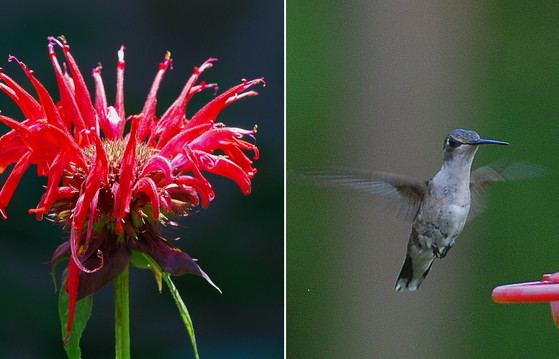 Beebalm can lure hummers, even in May (Terry W. Johnson)
(Editor’s note: This Out My Backdoor entry is not about bee balm somehow contributing to fewer hummingbirds, but a two-fer of Terry’s columns. Enjoy!)
By TERRY W. JOHNSON
Beebalm is one of the native wildflowers rapidly gaining popularity among Georgia gardeners.
And while each wildflower species has a unique story about how it made the often-difficult transition from the wild to our gardens, the tale of beebalm is as intriguing as the plant is beautiful and beneficial to wildlife, including hummingbirds.
Learn more about beebalm ...
Now, as for hummers, I’ve been receiving emails from Georgians wondering why they haven’t been seeing many this month. The hummingbird “drought” follows on the heels of March and April, when many said the beloved birds were also scarce.
Ever since I began watching hummingbirds decades ago, I have noticed that these winged jewels seemingly vanish from our backyards in May. Here are what I consider the main reasons why.
Follow Terry's line of reasoning ...
Terry W. Johnson is a retired DNR program manager and executive director of TERN, the Wildlife Conservation Section’s friends group. Check out past columns, his Backyard Wildlife Connection blog and his book “A Journey of Discovery: Monroe County Outdoors.” Terry's columns are also featured on DNR’s blog, under the Conservation tab. Permission is required to reprint a column.
Top
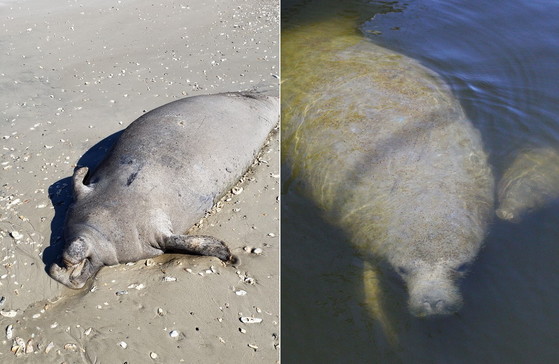 A dead manatee in the mouth of the Altamaha; at right, a mom and calf (DNR)
It’s not known yet if the adult manatee found dead at the mouth of the Altamaha River last month is a harbinger of trouble to come.
But a necropsy of the 1,500-pound animal suggests its demise is connected to the die-off of more than 700 manatees along Florida’s Atlantic Coast this year. DNR senior wildlife biologist Clay George said the Altamaha manatee had a GI tract full of marsh grass, yet its fat stores were severely depleted.
A decline in seagrass – which manatees eat – caused by poor water quality is seen as a leading culprit in Florida's surge of distressed and dying manatees. (A second factor is sub-average winter temperatures that bunched animals at manmade warm-water sites, such as power plants, where there wasn’t enough food.)
Manatees migrating to Georgia will find an all-they-can-munch buffet of cordgrass and other marsh vegetation. But the fallout from chronic malnutrition and the stress of migration could catch up with some animals. As it likely did with the manatee that died in the Altamaha.
“It remains to be seen if we will see an uptick in mortality as more manatees begin arriving,” George said.
From March into November, manatees occur in tidal waters throughout coastal Georgia. Federal agencies have declared the mass deaths in Florida an Unusual Mortality Event. (The 724 dead manatees documented through last week is three times the average number). Manatees are protected by federal and state laws.
WATCH WHILE BOATING
Boaters can help protect manatees by:
- Looking for manatees before cranking your boat’s motor.
- Using caution when navigating in shallow water and along the edge of a marsh. Manatees cannot dive away from boats in these areas.
- Heeding “slow speed,” “no wake” and manatee warning signs, especially around docks.
- Wearing polarized sunglasses to reduce glare and make it easier to spot manatees below the surface.
- Watching for trails of large swirls in the water (called footprints) caused by manatees diving away from the boat.
MORE ON MANATEES
-
West Indian manatees, including the Florida subspecies found in Georgia, are protected under the Endangered Species Act (they are listed as threatened) and Marine Mammal Protection Act.
- If you see or photograph a healthy, hurt or dead manatee, call DNR at (800) 2-SAVE-ME (800-272-8363). Note the date, time, location, number of manatees and, if possible, coordinates.
- Never feed manatees or give them fresh water. This could teach them to approach docks, putting them at greater risk of a boat strike.
- Do not pursue, harass or play with manatees. It can be harmful to the animals and it’s illegal.
Top
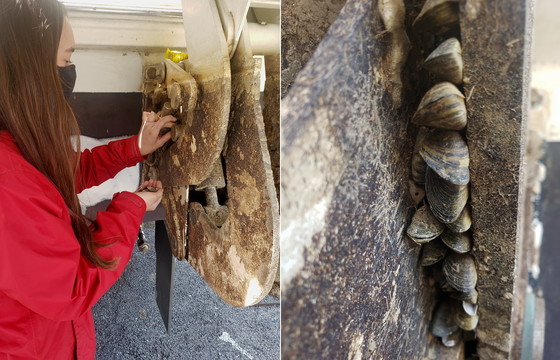 DNR technician Anna Raney collects zebras clustered on a boat near Lake Lanier (DNR)
In March, Georgia DNR urged Georgians to avoid aquarium moss balls possibly infected with zebra mussels, and explained how to properly dispose of the products.
After the invasive mussels were discovered on a boat near Lake Lanier last month, the agency called on Georgia boat owners to clean, drain and dry their vessels when moving them between water bodies.
The threat justifies the alerts. These small mollusks native to eastern Europe but now established in many U.S. waters multiply fast, foul boats, clog water intake pipes, filter out algae that native wildlife need and outcompete native mussels.
In short, they can wreak ecological and economic havoc.
When zebra mussels were spotted on a vessel bought in Tennessee and hauled to Georgia, the find highlighted the risk of them hitchhiking here. The boat, which was not launched at Lanier before the mussels were found, had been near Chattanooga in the Tennessee River, which is infected with zebras.
The owner contacted DNR. Aquatics biologist Matthew Rowe and technician Anna Raney helped remove the mussels, collecting about a gallon of dead ones … and raising more concern about the mini-invaders.
WHAT YOU CAN DO
Georgia has no known populations of zebra mussels. To help the state stay that way:
- Report non-native aquatic species to a local DNR office. (Quagga mussels – as problematic as zebras – were also found in moss balls the agency analyzed.)
- Remember that when moving a boat between water bodies, whether in-state or out, thoroughly clean, drain and dry it before launching again.
- Remove any non-native aquatic species you catch or collect.
- Reach others with the news about aquatic invaders – pick up a poster about Georgia’s worst at DNR Wildlife Resources Division fisheries offices (or download one) – and learn more at georgiawildlife.com/ans.
Top
 Loggerhead tracks to and from 2021's first nest, on Little Cumberland (Russell Regnery/Little Cumberland)
Sea turtle nesting is on. Little Cumberland Island, where loggerhead nest monitoring started in Georgia, kicked off the 2021 season with the state’s first loggerhead nest May 1. Nest totals vary year to year, but the Georgia Sea Turtle Cooperative’s work to find, monitor and protect nests doesn’t waver (even when surveying Little St. Simons Island’s six-plus miles of beach by bike). For more:
A game-changer for nongame, Recovering America’s Wildlife Act is back in Congress. The bipartisan, no-new-taxes bill reintroduced on Earth Day would provide $1.4 billion a year for states and tribal lands to conserve nearly 12,000 at-risk animal and plant species. That includes 639 in Georgia, which would see its federal funding rise from about $1.4 million a year in State Wildlife Grants to a preliminary estimate of $27 million for conservation.
What’s that buzz about cicadas? Just that after 17 years underground, Brood X is emerging across 15 states, with the big insects’ lawn mower-like drone rising in some far northeast Georgia counties.
Top
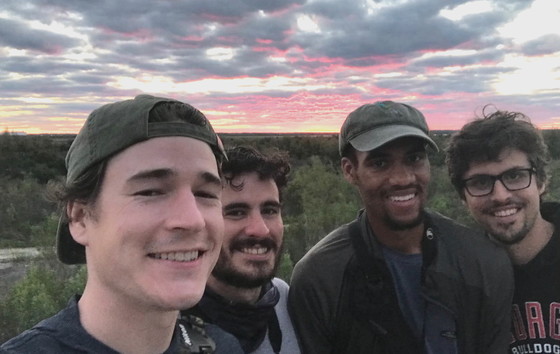 Big Day crew on Andrews Island: (from left) John Mark Simmons, Mac McCall, Patrick Maurice and Josiah Lavender
Four 20-something Georgians shattered the state record for bird species seen or heard in a day April 25. From midnight to midnight, John Mark Simmons, Patrick Maurice, Josiah Lavender and Mac McCall scoured bird hotspots from Athens to Brunswick to find 196 species, topping the 193 Big Day mark set in 2004.
Visit the Colonial Coast Birding Trail and bag some swag. Simply take a photo at any trail site, submit it at georgiabirdingtrails.com by May 31, then watch your mail for a free Georgia Birding and Wildlife Trails lens cloth and sticker. (And don’t forget to tag @georgiawildlife when posting to social media.)
White-nose syndrome continues to creep across North America, the latest advances including a dead bat with signs of the disease in Montana and two New Mexico caves testing positive for the fungal pathogen that causes WNS. A research project contributed to by DNR’s bat biologists and survey crew determined that WNS has killed more than 90 percent of three hibernating bat species in the U.S.
Top
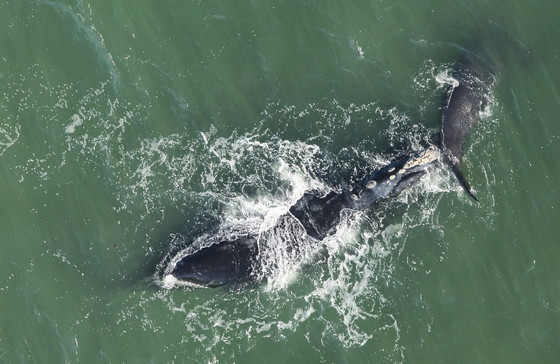 Right whale "Magic" with calf off the Georgia coast Jan. 4 (Florida FWC/NOAA permit 20556-01)
With the North Atlantic right whale calving season a wrap, DNR and partners documented 17 mom/calf pairs, the most since 2015. The downside is that counts averaged 22 a year from 2000-2009, and this winter in the Southeast saw deaths from entanglement and a vessel strike, the leading threats to the species. (Update from Canada: Crews try to disentangle a right whale off News Brunswick.)
The toxin killing bald eagles and waterfowl at Clarks Hill Lake and other southeastern waters is a mystery no more. International and UGA scientists identified the molecule that triggers vacuolar myelinopathy, the deadly disease linked to a blue-green algae that can grow on hydrilla, an invasive water plant.
Suwannee alligator snapping turtles should be listed as threatened under the Endangered Species Act, according to the U.S. Fish and Wildlife Service. The proposal estimates there are about 2,000 of the big snappers found only in the Suwannee River basin in south Georgia and Florida ("Snapper survey," March 25).
Top
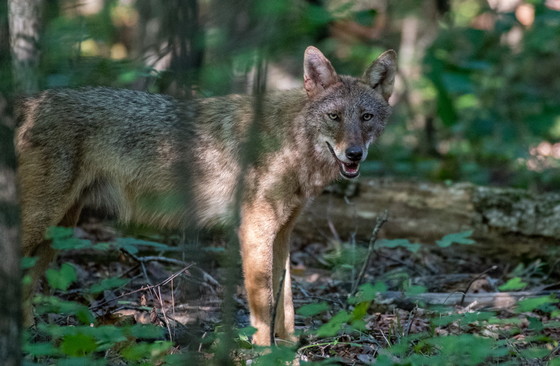 A coyote in metro Atlanta (John Kelly/GNPA)
Wildlife conflicts are most often caused by what DNR Urban Wildlife Program Manager Kaitlin Goode calls “easy-food opportunities.” Keeping non-natural foods away from wildlife is up to people, and helps ensure their safety and the animals’, Goode said. Answers and more on resolving wildlife conflicts.
Case in point: Black bears are on the move, spurred by a post-hibernation hunger than can lead to garbage cans and bird feeders. Check out the education program BearWise for tips on how best to keep bruins out of your backyard.
A Beyond BOW in the Blue Ridge immersed 14 women in a weekend of outdoor adventure. Participants in the recent Becoming an Outdoors Woman program hiked, mist-netted bats, fly-fished and sampled a stream for fish by snorkel and seine.
Top
 Sean O'Brien and Jackie Aliperti check persistent trilliums with DNR botanist Carlee Steppe. (Beth Quillian/DNR)
On his van tour across the continent, NatureServe President Sean O’Brien explored DNR’s work with endangered persistent trillium and habitats at Tallulah Gorge and involving sicklefin redhorse, a candidate for federal listing, at Brasstown Creek in Towns County. NatureServe networks with more than 100 programs to power a Biotics database vital to conserving at-risk species and ecosystems.
UGA ecologists Mary and “Bud” Freeman have spent decades studying and conserving the Southeast’s freshwater fishes, especially in the Etowah River watershed. Which makes naming the new species Etowah bridled darter (Percina freemanorum) after them a most fitting honor (“orum” indicates group or pair).
Registration is open for this year’s north Georgia meeting of the Georgia Prescribed Fire Council. The virtual session set for June 3 will cover topics varying from the role of prescribed fire in regenerating oaks and shortleaf pine and fire management for northern bobwhites north of the Fall Line.
Top
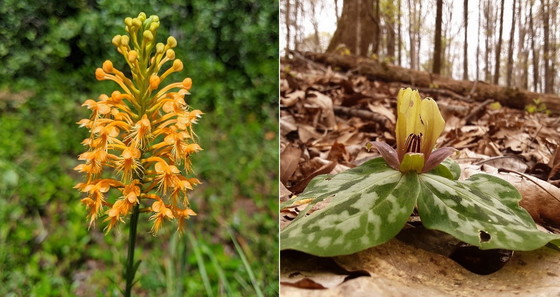 Chapman's fringed orchid, left, and relict trillium (DNR)
More on trilliums: DNR’s Nate Thomas found pale yellow trillium, previously known only from the Savannah River watershed, in the Little Tennessee River watershed in Rabun County. Also, a statewide survey of endangered relict trillium checked known sites and added new ones, with botanists seeing thousands of plants.
One of the world’s rarest orchids is benefiting from DNR carefully mowing scattered populations along southeast Georgia roads. Chapman’s fringed orchid, a conservation priority in Georgia’s State Wildlife Action Plan, is a fire-adapted, wet flatwoods species that needs open, sunlit conditions, which mowing can mimic.
Got wild hogs? Two free workshops geared toward farmers and landowners will provide trapping demonstrations and insights from feral swine experts May 20 at UGA’s Southeast Georgia Research and Education Center in Midville.
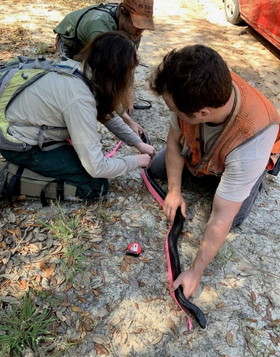
Names in the news: DNR’s Jacob Wilson and members of the gopher tortoise survey crew found this almost 7-foot-long eastern indigo snake while marking tortoise burrows on a south Georgia wildlife management area. The adult male snake had been originally tagged during a DNR indigo survey in 2018. Bob Sargent, a DNR Wildlife Conservation Section program manager, organized a volunteer workday at a Macon park that removed an estimated 6,000 cubic feet of invasive plants, including Chinese privet, English ivy and autumn olive. In a study published in Herpetological Conservation and Biology, retired DNR senior wildlife biologist John Jensen and Piedmont College professor Carlos Camp documented 19 years of salamander abundance in the “twilight” zones of Georgia caves on state lands. DNR Corp. Daniel Stiles has been named the state’s Hunter Education Instructor of the Year.
Correction: This year's finch irruption crowded Georgia feeders with pine siskins and purple finches. A brief in the March Georgia Wild listed an incorrect species.
|
WHAT YOU MISSED ...
In the previous Georgia Wild:
- Mussel invaders found in moss balls
- When right whale threats end in death
- Eagle nest failures and a turkey takedown
- The amazing moth life at Sandhills West
Top
"$1.4B wildlife bill best chance of passing this time," Milwaukee Journal Sentinel
"DNR warns about invasive mussels found on boat," WAGA-TV (Ch. 5, Atlanta)
"Judge asked to halt dredges during sea turtle nesting season," Associated Press
"Boating caution: Slow down, watch for manatees, sea turtles," AllonGeorgia
"Tall Timbers receives Conserve Georgia grant for Birdsong easement," Thomasville Times-Enterprise
"Feds propose protection for Suwannee snapper," Georgia Public Broadcasting
"Beach visitors, be aware of nesting shorebirds," Yahoo! News (sharing a Brunswick News article)
(+video) "They're here: Brood X cicadas coming out," WSB-TV (Ch. 2, Atlanta)
"The botanist who defied Stalin," Nautilus
"Unsung heroes of American conservation," U.S. Fish and Wildlife Service
"Post-pandemic: What do we want to be?" Bird Watcher's Digest
"If you care, leave them there," Henry (County) Herald
"Administration to restore migratory bird protections," Georgia Recorder
"Right whale births show encouraging rebound," Yale Environment 360
(+video) "Rare video of right whale behavior," WCVB-TV (Ch. 5, Needham, Mass.)
"Ga.'s daunting task tracking rare species," The Atlanta Journal-Constitution
(+audio) "Bald eagles bounce back across U.S. and Ga.," WABE-FM (90.1, Atlanta)
"Man connected with Valdosta snake scare indicted," Valdosta Daily Times. Also: U.S. Justice Department
"New reptile rules have breeders leaving, activists rejoicing," WUSF-FM (89.7, Tampa). Related: "Fla. invasives; they're coming for us," The Washington Post
"New fish species named in honor of UGA ecologists," Phys.org
"Recruiting nature to protect Southeast shoreline," The PEW Charitable Trusts
(+video) "Beachgoers push nesting sea turtle back into water," WSVN-TV (Miami)
"Invasion of forest destroyers; how science is fighting back," U.S. Forest Service
Top
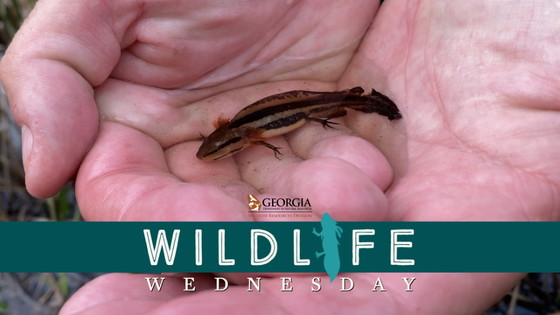 "Sampling Reticulated Flatwoods Salamanders," DNR
"How to Track Roosting Bats," DNR
"Talking Nature Tuesday: Burning Questions," DNR
(audio) "The Plight of the North Atlantic Right Whale," Science Friday
"Amazing Drone Footage of 1-year-old Right Whale," HDR
(audio) "A World on the Wing with Scott Weidensaul," American Birding Podcast
"Safely Refueling Your Vessel," DNR Law Enforcement
"Male Osprey Swoops in with Live Fish for Family," Cornell Lab Bird Cams
Top
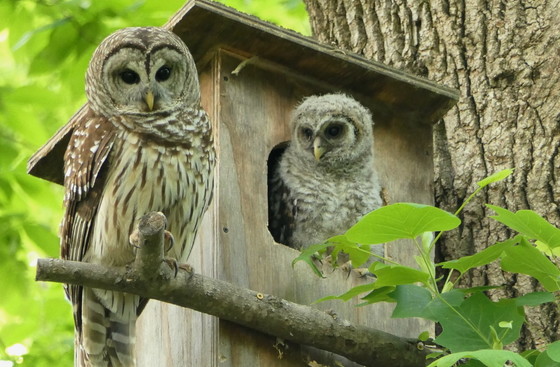 An adult barred owl and its young at the nest box on the Mays' property (Linda May/DNR)
Linda and Chris May enjoyed watching – and documenting – a family of barred owls coming of age in their Spalding County yard this spring. The Mays heard the owls when they moved to the neighborhood in 2019 and put up a nest box in January 2020. When the cavity tree the owls had been nesting in fell, the adults began using the nest box this winter. They raised one nestling, which fledged last month. Linda, outreach coordinator for DNR's Wildlife Conservation Section, said the family is still using the property to hunt and roost. “The parents are doing a great job raising the owlet. I watched them deliver ’possum parts to him yesterday.” The fledgling has its flight feathers and is flying short distances. Linda said she and Chris "are thrilled to share our woodland with such fascinating creatures!”
CREDITS
Masthead: Manatees (DNR)
DNR's gopher tortoise crew checks an eastern indigo found on a south Georgia WMA (DNR)
Top
|